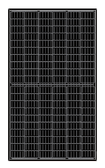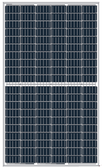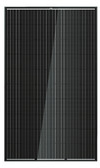 Loading... Please wait...
Loading... Please wait...Products
- Solar Panels
- Solar Panel Kits
- Solar Generators
- Inverters
- Inverter Monitoring
- Inverter Accessories
- Balance of Systems
- Racking and Mounting
- Rails
- Flashings
- Splice Kits
- Stopper Sleeves
- Conduit Mounts
- Attachments
- Brace Assembly
- Base Mount
- Brackets
- Bolts
- Clamps
- Caps
- L-Feet
- Washers
- Skirt
- Lugs
- Tilt Legs
- Hooks
- Stand-Offs
- Ballast Bay
- Top of Pole Mount
- Side of Pole Mount
- Flush Mount Kits
- Ground Mount Kits
- Roof Mount Kits
- Hardware Packages
- Wire Management
- Batteries
- Battery Accessories
- Charge Controllers
- Tools and Supplies
- View All Products
Solaris Blog - Longi Solar Panels
Longi vs Trina Solar Panels: What's Best?
Posted by Brandi Casey on 22nd Nov 2019

Longi Solar and TrinaSolar are among the leading manufacturers of value-based, high efficiency solar modules. Both companies offer their modules at an affordable price point, making them an attractive option for systems on a budget that do not want to sacrifice quality. Both companies were founded in China, TrinaSolar in 1997 and Longi Solar not long after in 2000. Over their combined twenty years experience they have earned awards in innovation, technology and efficiency for their solar panels and solar cells.
In tune with market trends, solar panel offerings from both companies are high-watt monocrystalline modules and provide excellent efficiency ratings even in low light regions. The modules have been tested to withstand extreme environmental conditions such as heavy snow loads, high winds, hail, high salt content, and more. Making both Longi and Trina solar panels good solutions across a wide array of environments.
Throughout their years of combined research, the companies have explored p-type, LID, monocrystalline, polycrystalline, n-type and bifacial solar module technologies. At times, they have lead the market in exploring new energy technologies. Their solar panels have been used in a number of residential and large scale installations.
In this comparison between Longi and Trina solar panels, we will be looking at the following:
- Specifications and Pricing
- Average Costs and Potential ROI
- Warranty Comparison
- Solaris Recommendations
See Here: Longi Solar Panels for Sale
See Here: Trina Solar Panels for Sale
Specifications and Pricing
Longi and Trina solar panels are both well known for their value based cost and high efficiency rating. In terms of average efficiency rates, TrinaSolar comes out on top at 19.18% efficiency in comparison to Longi at 18.58% average efficiency. Both manufacturers hold higher average ratings than the industry averages, and operate well in low light environments, providing more energy than similar modules under similar lighting conditions.
When comparing similar watt panels, the differences between the electrical specifications is nearly matched. For example: the efficiency rate of the Longi 310w module below is 18.7% in comparison to Trina's 310w at 18.9% efficiency. This 0.2% of difference is negligible in day to day operations; furthermore, when comparing Longi and Trina's expected degradation rate and output at the 25 year benchmark, Longi promises a higher output and lower degradation rate between the second and twenty-fifth year.
It is important to consider the expected output of your modules for both present and future energy use. Higher efficiency may be negated over time when degradation and expected output are factored. With that being said, both manufactures offer impressive modules with high energy output and strong 25 year benchmark expected output ratings.
|
Longi Solar |
Model Number | Max. Power | Efficiency | Cell Count | Technology | Downloads |
 |
LR6-60HPB-305M |
305 Watts | 18.20% | 120 Half Cut (60) | Monocrystalline |
Specifications Warranty |
 |
LR6-60HPH-310M |
310 Watts | 18.70% | 120 Half Cut (60) | Monocrystalline |
Specifications Warranty |
 |
LR6-72PH-360M |
360 Watts | 18.60% | 72 | Monocrystalline |
Specifications Warranty |
 |
LR6-72-365M |
365 Watts | 18.80% | 72 | Monocrystalline |
Specifications Warranty |
|
TrinaSolar |
Model Number | Watts | Efficiency | Cell Count | Technology | Downloads |
 |
TSM-310-DD05A.05(II) |
310 Watts | 18.90% | 60 Cell | Monocrystalline |
Specifications Warranty |
 |
TSM-370-DE14A(II) |
370 Watts | 19.00% | 72 Cell | Monocrystalline |
Specifications Warranty |
 |
TSM-375-DE14A(II) |
375 Watts | 19.30% | 72 Cell | Monocrystalline |
Specifications Warranty |
 |
TSM-380-DE14A(II) |
380 Watts | 19.50% | 72 Cell | Monocrystalline |
Specifications Warranty |
Average Cost and Potential ROI
On average, Longi solar panels start at $0.59/watt, whereas Trina solar panels start at $0.63/watt. This price point less on average than other low cost solar panel manufacturers such as mid-range panels such as Canadian Solar, ($0.10 less for Longi and $0.06 less for Trina). When comparing the modules to high range panels, both Longi and Trina come in well below average costs from manufacturers like LG and Panasonic.
The efficiency rating between Longi and Trina is similar or better than the mid-range average noted below from Canadian. Though it should be noted that panel to panel comparisons are a more accurate way to compare the modules. Both LG and Panasonic offer the highest efficiency ratings with some modules coming in at above 20% efficiency.
| Manufacturer | Average Cost | Average Efficiency | Warranty |
| Longi Solar | $0.59/watt | 18.58% | 10-yr Product | 25-yr Performance |
| Trina Solar | $0.63/watt | 19.18% |
10-yr Product | 25-yr Performance |
| Canadian Solar | $0.69/watt | 18.99% | 10-yr Product | 25-yr Performance |
| Panasonic | $0.95/watt | 19.99% | 25-yr Product | 25-yr Performance |
Next, let's take a look at the potential ROI for two similar systems from both Longi and Trina Solar. For the purposes of comparison, we will be composing a system of 24 310w solar panels to create two 7.44kW systems capable of generating approximately 10,800kWh per year, or 900kWh per month (the average kWh usage in the United States.
See Here: How Much Does the Average DIY Solar System Cost?
Both systems will be composed of the same composition roof mount system from IronRidge, in a 2x24 portrait configuration. Finally, we will be using the Enphase Energy IQ7 microinverters, trunk cables, accessories and Envoy monitoring solution to complete the systems. Installation costs are not included in this DIY scenario, if you plan to use an outside installation company, be sure to account for their costs when generating your ROI estimation using the calculations below
Longi Solar |
TrinaSolar |
|
| Solar Panels |
LR6-60HPH-310M |
TSM-310-DD05A.05(II) |
| Microinverters |
Enphase IQ7-60-2-US |
Enphase IQ7-60-2-US |
| Accessories |
Trunk Cable Termination Caps Disconnect Tool |
Trunk Cable Termination Caps Disconnect Tool |
| Monitoring |
IQ+ Combiner with Envoy |
IQ+ Combiner with Envoy |
| Roof Mount Racking |
IronRidge Rails Splices Universal Module Clamps Stopper Sleeves Grounding Lugs Flashings Bonding Hardware Wire Clips End Caps Micro. Mounting Hardware Conduit Mounts |
IronRidge Rails Splices Universal Module Clamps Stopper Sleeves Grounding Lugs Flashings Bonding Hardware Wire Clips End Caps Micro. Mounting Hardware Conduit Mounts |
| Other |
Permit Plan Set Labels |
Permit Plan Set Labels |
| Sub Total | $10,407.04 | $10,384.24 |
| Est. Shipping | $410.00 | $410.00 |
| Avg. Total | $10,817.04 | $10,794.24 |
*Prices based on pricing as of the posting of this article
The Longi system comes to $10,817.04 while the Trina System costs $10,794.24 before possible solar energy tax rebates and incentives, making them almost identical in costs for major components. Both Longi and solar average out to be $1.45/watt, including shipping and your permit plan set.
Both systems should be producing about 10,800kWh annually, and 900kWh per month. By taking the average cost per kilowatt hour in the United States (currently $0.12/kWh), we can determine the projected monthly savings of the system.
900kWh/month x $0.12kWh = $108 monthly savings
In order for the systems to pay for themselves, (excluding other factors such as installation costs, balance of systems items, rebates and incentives and so on). Longi's ROI period is ~100 months or 8.33 years while TrinaSolar's ROI period is ~99.94 months also an average of 8.33 years.
As broken down above, the systems are very similar in overall costs, and, in some cases, they are identical. Likewise, the efficiency rating of both panels is close, with only 0.20% difference separating them.
Warranty Comparison
Both Longi and Trina offer 10 year product and 25 year linear performance warranties. This is in keeping with average industry standards, the product warranty is outdone by manufacturers such as LG and Panasonic, both of which offer 25 year product and 25 year linear performance warranties.
At 83.8% output at the 25 year benchmark, Longi has a higher expected output than Trina which promises at least 80.68% output. Both panels degradation rate is highest during their first year of operation (3%), between the second and 25th year, Longi's degradation rate falls to 0.55% and Trina's degradation rate decreases to 0.68%.
See Here: Longi Warranty Statement
See Here: Trina Warranty Statement
Solaris Recommendations
Longi and Trina solar panels come at a value-based price point with industry standard warranties, and above average efficiency ratings. In addition both companies panels work well in low irradiance, which improves efficiency in low light regions, during cloudy days and so on, making them highly reliable.
There is a great deal of overlap between the companies in terms of price point and efficiency ratings. The primary point of difference between Longi and Trina is expected energy output of the panels 25 year mark. This means that the maximum expected output from the Longi 310w is expected to be 259.78 watts, whereas the Trina 310w panel's output would be approximately 250.10 watts. While system calculations account for average degradation rates, expected maximum output is worth noting.
Technical and warranty support from Longi and Trina is available through their websites via contact form. They also have offices in the United States that be contacted for technical support (installation, troubleshooting, and so on), as well as assistance for warranty claims. Overall reports of the solar manufacturer's customer support is largely positive.
In terms of installation, both Longi and Trina solar panels can be installed in both residential and commercial applications. In addition, the panels are approved for roof top, ground mount and top of pole installation sites. The panels are compatible with the majority of inverter solutions on the market, both panel manufacturers and we think Longi and Trina should be considered for your next solar energy project.
See Here: Longi Solar Panels: The Complete Review
See Here: Trina Solar Panels: The Complete Review

Longi Solar Panels: The Complete Review
Longi Solar is a leading manufacturer of reliable, technologically advanced, value-based monocrystalline solar panels. Established in 2000, the company is headquartered in China; where they continually innovate cell technology with their in-depth R&D, as well as produce their modules. Longi contributes to approximately a quarter of the solar panel market demand, and holds the highest [...]



